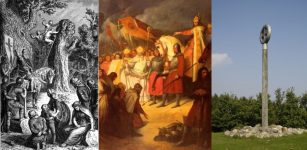Nammu: Sumerian Goddess Who Got The Idea To Create Mankind In The Image Of Gods
A. Sutherland - AncientPages.com - In Sumerian mythology, Nammu (Namma) was the "primeval sea" - the ultimate origin of everything.
The goddess Nammu gave birth to the heavens and the earth and life to the first couple of gods.
More exactly, she gave birth to the male sky god, An, and the female earth goddess, Ki, whose union, in turn, produced the god Enlil (Air), source of the ordered universe, responsible for cattle, agriculture tools, vegetation, and the arts of civilization. Man was created to serve the gods and provide them with nourishment.
Nammu /Namma), a primeval goddess, who gave birth to An (heaven) and Ki (earth) and the first gods; Right: Enki god of the god of wisdom, creator, protector of humanity and the patron of craftsmen and artisans.
Nammu represented the oldest generation of Mesopotamia’s deities and was the mother of the god Enki (Ea), the Sumerian water god of Eridu, located in the southern wetlands of what is today Iraq. Enki was also the god of wisdom, creator, protector of humanity, and patron of craftsmen and artisans.
Not much is known about the Eridu goddess, Nammu, but she may have been a much more important prehistoric deity in the times before her son Enki took over most of her tasks.
Enki’s birth as the son of the goddess Nammu is attested in the Neo-Sumerian mythological text entitled “Enki and Ninmah.” It is said that Nammu got the idea to create mankind in the image of gods; however, to do this, she had to consult her son Enki, who gave his mother instructions on how to fashion man.
Samuel Noah Kramer, Assyriologist and a world-renowned expert in Sumerian history, writes that the poem begins with what may be a description of the difficulties of the gods in procuring their bread, especially after the female deities had come into being.
The gods complain, but Enki, the water god— as the Sumerian god of wisdom who is expected to come to their aid—is lying asleep in the deep and fails to hear them.
Enki gives the matter thought, leads forth the host of "good and princely fashioners," and says to his mother, Nammu, the primeval sea:
"O my mother, the creature whose name you uttered, it exists,
Bind upon it the image of the gods;
Mix the heart of the clay that is over the abyss,
The good and princely fashioners will thicken the clay..."
In the Sumerian poem “Enki and Ninmah,” Nammu’s role in Mesopotamian cosmology is particularly emphasized. Still later, however, in other texts such as the Akkadian ones, Nammu lost her importance, being only mentioned infrequently. In a later myth of Sumer, she became known as Tiamat.
The Mesopotamian scribes depicted and described Nammu as a goddess without a husband, the self-procreating womb of the universe. No male divine deity in connection with Nammu was ever mentioned in ancient Mesopotamian sources.
This led to the belief that the first cosmic production was asexual, according to the Sumerian creation myth.
Very little historical information can attest to cult places for the goddess Nammu, representing the oldest generation of Mesopotamian deities.
Her latest reference dates to the Neo-Babylonian period, when King Nabonidus (556 until 539 BC), the last king of Babylonia, mentioned Nammu’s shrine as part of the Esagil, known as the temple constructed to honor Marduk, the protector god of Babylon and located south of the ziggurat Etemenanki.
Updated on January 26, 2024
Written by – A. Sutherland - AncientPages.com Senior Staff Writer
Copyright © AncientPages.com All rights reserved. This material may not be published, broadcast, rewritten or redistributed in whole or part without the express written permission of AncientPages.com
Expand for referencesReferences:
Kramer N. Samuel, History Begins At Sumer
Leick G. A dictionary of ancient Near Eastern mythology
More From Ancient Pages
-
 Will-o’-the-wisp: Eerie Lights Over Swamps And Marshes That Frightened And Led People Astray
Featured Stories | Apr 23, 2020
Will-o’-the-wisp: Eerie Lights Over Swamps And Marshes That Frightened And Led People Astray
Featured Stories | Apr 23, 2020 -
 ‘Green’ Saudi Arabia Was Home To A 350,000-Year-Old Human Settlement
Archaeology | May 18, 2021
‘Green’ Saudi Arabia Was Home To A 350,000-Year-Old Human Settlement
Archaeology | May 18, 2021 -
 Capernaum – Was The City On The Sea Jesus’ Home?
Biblical Mysteries | Jan 25, 2019
Capernaum – Was The City On The Sea Jesus’ Home?
Biblical Mysteries | Jan 25, 2019 -
 Fomorians: Supernatural Race Of Giants Who Came From Atlantis
Celtic Mythology | Jul 18, 2017
Fomorians: Supernatural Race Of Giants Who Came From Atlantis
Celtic Mythology | Jul 18, 2017 -
 Irminsul – Mysterious Sacred Symbol Of The Saxons – Is It Linked To Yggdrasil And God Odin?
Ancient Symbols | Feb 11, 2019
Irminsul – Mysterious Sacred Symbol Of The Saxons – Is It Linked To Yggdrasil And God Odin?
Ancient Symbols | Feb 11, 2019 -
 Mystery Of Pre-Adamic Didanum Race: Giants Who Were Ancestors Of The Nephilim and Rephaim
Biblical Mysteries | Oct 2, 2014
Mystery Of Pre-Adamic Didanum Race: Giants Who Were Ancestors Of The Nephilim and Rephaim
Biblical Mysteries | Oct 2, 2014 -
 The Third Greatest Fire Temple That Existed In Ancient Iran’s Sassanid Age – Unearthed
Archaeology | Jul 8, 2022
The Third Greatest Fire Temple That Existed In Ancient Iran’s Sassanid Age – Unearthed
Archaeology | Jul 8, 2022 -
 Daily Life Of Ancient Maya
Ancient History Facts | Oct 12, 2020
Daily Life Of Ancient Maya
Ancient History Facts | Oct 12, 2020 -
 New Light On Foodways In The First Cities In Mesopotamia
Archaeology | Nov 21, 2022
New Light On Foodways In The First Cities In Mesopotamia
Archaeology | Nov 21, 2022 -
 On This Day In History: Chaldean Account Of The Deluge Translated And Presented For The First Time – On Dec 3, 1872
News | Dec 3, 2016
On This Day In History: Chaldean Account Of The Deluge Translated And Presented For The First Time – On Dec 3, 1872
News | Dec 3, 2016 -
 House Of Borgia – The Most Infamous Family Of Renaissance Italy
Featured Stories | Feb 28, 2019
House Of Borgia – The Most Infamous Family Of Renaissance Italy
Featured Stories | Feb 28, 2019 -
 Hades – ‘The Unseen’ God Of The Dead, Fertility, Wealth And Earth’s Minerals
Featured Stories | Jun 2, 2020
Hades – ‘The Unseen’ God Of The Dead, Fertility, Wealth And Earth’s Minerals
Featured Stories | Jun 2, 2020 -
 DNA Offers Insights Into The Use Of Plants By Humans In The Paleolithic Age
Archaeology | Oct 13, 2022
DNA Offers Insights Into The Use Of Plants By Humans In The Paleolithic Age
Archaeology | Oct 13, 2022 -
 Well-Known Powerful Yin Yang Symbol Dates Back To Ancient China
Ancient Symbols | Sep 23, 2016
Well-Known Powerful Yin Yang Symbol Dates Back To Ancient China
Ancient Symbols | Sep 23, 2016 -
 Crimean Atlantis: Remarkable Ancient Underwater City Of Akra
Featured Stories | Mar 6, 2017
Crimean Atlantis: Remarkable Ancient Underwater City Of Akra
Featured Stories | Mar 6, 2017 -
 Mysterious Visitors From Other Realms And Enigma Of Atmospheric Phenomena
Featured Stories | Jul 19, 2018
Mysterious Visitors From Other Realms And Enigma Of Atmospheric Phenomena
Featured Stories | Jul 19, 2018 -
 Mystery Of Dakhamunzu And The Zannanza Affair – Was Queen Ankhesenamun Hiding Her Identity?
Featured Stories | Feb 1, 2019
Mystery Of Dakhamunzu And The Zannanza Affair – Was Queen Ankhesenamun Hiding Her Identity?
Featured Stories | Feb 1, 2019 -
 The Hobbit – An Ancient Hominin Species May Still Be Living In The Forests Of Flores Island – Anthropologist Says
Archaeology | Apr 20, 2022
The Hobbit – An Ancient Hominin Species May Still Be Living In The Forests Of Flores Island – Anthropologist Says
Archaeology | Apr 20, 2022 -
 Mystery Of The Avars Who Conquered The Roman Empire Solved By Scientists
Civilizations | Apr 1, 2022
Mystery Of The Avars Who Conquered The Roman Empire Solved By Scientists
Civilizations | Apr 1, 2022 -
 Cernunnos ‘Horned One’ – Powerful Continental God Preserved In Celtic Beliefs As Master Of Animals
Celtic Mythology | Dec 18, 2018
Cernunnos ‘Horned One’ – Powerful Continental God Preserved In Celtic Beliefs As Master Of Animals
Celtic Mythology | Dec 18, 2018

